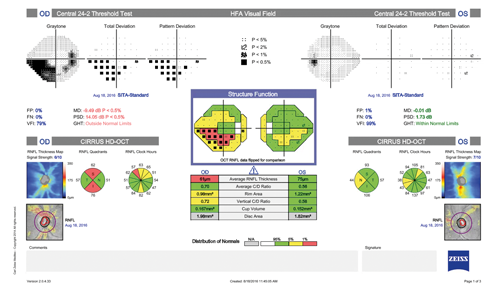The tech column this issue reports on the features and experience of using the Zeiss Forum software. I have overseen the installation, troubleshooting, training and use of the software over the last two years. As both a consultant specialising in glaucoma and part of the informatics team I am able to comment on both the technical and clinical aspects of the product.
What is it?
Zeiss Forum (or just Forum from now on) is software designed primarily to connect Zeiss ophthalmic devices together, and by doing so, increase their functionality. The main devices of relevance in NHS environments are Humphrey Field Analysers (HFAs), Cirrus (and other) Zeiss OCT Scanners and also IOL Master devices. The software fits into the category on an ophthalmic Picture Archiving and Communication Software (PACS). Forum is made of two components, the Forum Viewer and the Forum Server. The Viewer is a program that is installed on clinical PCs and is how tests are viewed. Forum Server is a program that typically runs on a powerful computer in the IT department (a server). The Zeiss devices are connected via the network to that central server.
What does it offer?
Outlined below are some of the most useful features of Forum:
Centralised storage – Zeiss devices connected to the Forum Server no longer store their test results locally. Instead they send them all to the Forum Server. This means all your Zeiss data is stored in one place, making backup much easier. Failure of an individual device won’t threaten stored data either.
Paperless field reports – Forum supports the drive toward electronic health records, allowing visual fields to be viewed without printing. The same feature can also be used to support virtual clinics.
Guided Progression Analysis (GPA) – Historically, the majority of UK clinicians have used the Pattern Deviation, Mean Deviation and Glaucoma Hemifield Test values to judge glaucoma progression. These can still be viewed in Forum, but the GPA tools provide rich progression analysis features. The data is presented in a number of formats, including a graph of Visual Field Index (VFI) against age and also a progression field image. An example can be seen in Figure 1.

Figure 1.
Glaucoma Combined Structure Function Reports – If a Zeiss OCT scanner and a HFA are connected, Forum is able to generate these reports (Figure 2). The central area shows the latest pattern deviation map with the correlating retinal nerve fibre layer (RNFL) thicknesses overlaid. They are very useful in glaucoma suspects, when deciding if field defects correlate with disc damage.
Macular OCT progression analysis – In addition to all the glaucoma features, Forum can also view and report progression of macular OCT scans. The functions available are in excess of those provided by the traditional Zeiss software (Cirrus Review). Graphs of sub-foveal thickness over time and the ability to compare three scans at once are some of the features only present in Forum.
Repository for IOL Master data – Even though the IOLMaster isn’t a typical imaging device it can still be connected to Forum. This allows biometry data to be backed up and also pushed to an electronic health record.
Repository for non-Zeiss data – Although Forum adds features to Zeiss devices, non-Zeiss devices are still compatible. Most can be linked to Forum, allowing images, reports and videos to be viewed within the software. Many devices require their own software for optimal functioning, so aren’t well suited to being transferred to Zeiss Forum.
Modular structure
Some of the features above are part of the core product, yet some are part of extra paid components. For example, the GPA features reside within the Glaucoma Workplace. The retinal OCT reviewing and progression features are part of the Retina Workplace. Each of these modules requires additional licences on a concurrent user basis. For instance, a unit may buy five Retina Workplace licences. This would allow five users to use the Retina Workplace features simultaneously (no matter how many computers Forum Viewer is installed on).
Historic data
Field and OCT data stored on existing Zeiss devices will be transferred to the Forum Server on first connection. The historic field data is of great importance as it allows the GPA graphs to be created. It’s therefore important to ensure stored field data isn’t deleted from HFA devices if Forum is being considered.
The downside of historic data is that Forum isn’t great at recognising the same patient on two different machines. Many of the historic records will need merging before some of the advanced functionality works well. This issue is unavoidable with any complex historic dataset and doesn’t detract from the product.
Competing products
For HFA visual field analysis and progression, there are no direct competitors to Forum. Although progression analysis features are available on the individual HFA machines, Forum is required to utilise field data from a network of HFAs together. As is almost always the case, the OCT features are specific to Zeiss OCT scanners. Thus, Zeiss software is best for Zeiss OCT machines, Topcon software is best for Topcon OCT scanners and so on. Other pieces of software exist to allow different devices to store data in one place, but all again work best with their own brand hardware. For instance, Heidelberg use their HeyEx product and Topcon use Synergy. Other standalone PACS type products, like Merge Eye Care PACS, do exist but currently fall short when used to view OCT imaging, as the complex features of the device manufacturer’s software is lost.
Figure 2.
Opinion based on using Forum
Overall Forum is proving tremendously useful to patient management. The glaucoma workplace features, including GPA, have great value and easily replace the need for reviewing printed paper fields. The combination reports are also very useful in selected circumstances.
Our local glaucoma unit deployment consists of four HFAs (including one offsite), two Cirrus OCT scanners and a Kowa stereo disc camera. All of the instruments feed into Forum, which acts as an almost single store for the glaucoma data. This highlights the main area for improvement for the software. At present OCT progression analysis is not available in Forum. Cirrus Review (The Zeiss OCT review software) remains necessary for this function. Hopefully, in time, this feature will be added to Forum. Other shortcomings relate to the user-interface. There are a few quirks with the search function and navigating within the software that prevents the initial experience from being intuitive. Although the learning curve isn’t steep, it is there, and training in how to use the software is required.
Overall, from a clinical and IT perspective, Zeiss Forum functions very well and delivers what it promises.
Ultimately, the choice of an ophthalmic PACS depends greatly on what type of OCT scanning devices are involved. If Zeiss scanners are used, especially in the context of Humphrey field machines, Forum is the obvious choice. In other environments its field functions remain useful, but other storage and software will still likely be required to maximise the specific OCT features of other scanners.
COMMENTS ARE WELCOME






